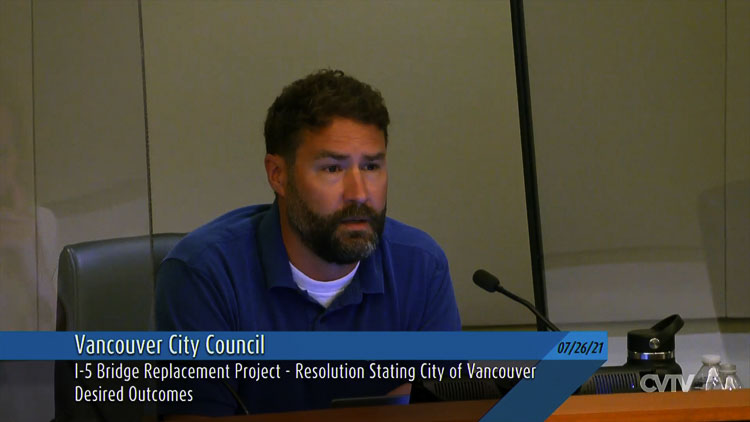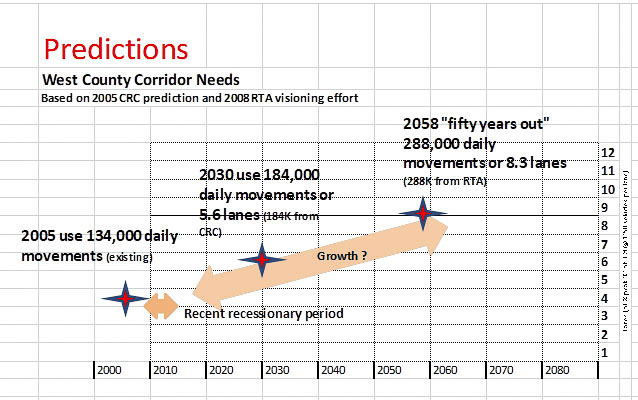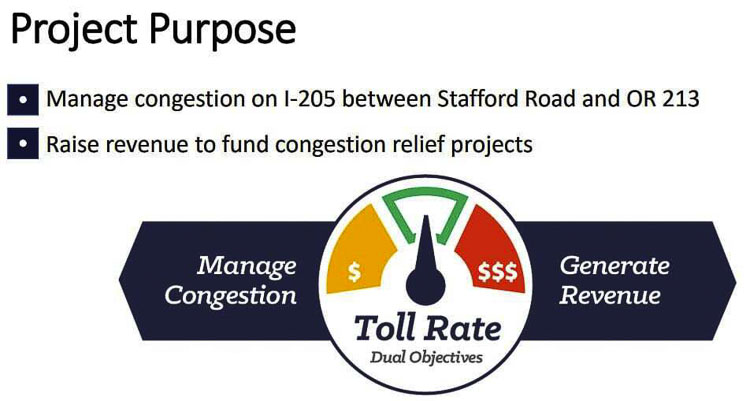Councilor Bart Hansen wants a 10-lane bridge, joins Councilor Sarah Fox in concerns about equitable tolling
For the third time in the past two months, members of the Vancouver City Council discussed the Interstate Bridge Replacement Program (IBRP), this time at their Monday meeting. The councilors ultimately passed a resolution calling for the bridge to be replaced, for there to be tolling to pay for the bridge, and more. While there is no specific bridge design yet proposed, they hope to influence the IBRP team.
Two weeks ago and a month ago the council discussed ideas for transit connections to downtown Vancouver, a preference for light rail that terminated at Clark College, and a lid over I-5 at Evergreen, and connections to the waterfront.
Councilors Bart Hansen and Sarah Fox expressed the most concerns about what was and wasn’t specified in the resolution. Hansen was concerned that the congestion pricing form of tolling could be seen as “roads for the rich” who could afford the tolls. He believed the poor couldn’t afford the tolls and therefore wouldn’t benefit from any improvements.

Hansen is looking for a 10-lane bridge. “An eight-lane bridge is a problem for me,” he said. “I don’t think we’re solving much in congestion, if we build an eight-lane bridge.”
Transportation architect Kevin Peterson had studied all the traffic projection data during the Columbia River Crossing (CRC) debate. He identified the need for five lanes in each direction by 2030, and eight lanes in each direction by 2060. Hansen would welcome seeing updated traffic numbers.
Fox was concerned about equity and fairness issues. There is no specific language reflecting her concerns that the poor couldn’t afford the tolls, nor was it reasonable for the single mom to use transit in lieu of paying the tolls.
“We really need to think about all of those jobs that don’t have as much choice when it comes to changing the time of day that they travel,” she said. Fox was concerned about the large portion of the population that is below median income not being able to afford tolls.
Staff member Katherine Kelly responded by mentioning the IBRP has an Equity Advisory Group (EAG) addressing those equity issues. Fox responded saying the council members should express their concerns now, rather than regret not speaking up later.
Fox shared that she believed transit doesn’t work for single parents needing to make several drop offs for children at school or daycare, and then go to their jobs. “That doesn’t usually translate very well into hopping on a bus. Otherwise, you’re going to need to take three buses, it’s going to take you an hour and a half to get to work, where someone without children and many stops, will be able to do that same trip in 20 minutes,” she said.
Ty Stober wanted to insure it was a replacement bridge. He also objected to having a specific number of lanes mentioned.
No traffic congestion relief
“I’m not seeing a project that relieves congestion,” said Hansen, who is afraid the project could end up with fewer than 10 lanes, acknowledging that the top priority for average citizens is congestion relief. Hansen was afraid if it wasn’t specified that the project contain at least 10 lanes, it could end up with an eight-lane bridge being proposed.
Hansen spoke about the previous Columbia River Crossing (CRC) proposal and the traffic data that led to the creation of the CRC. “Were they wrong on (the data for) a $3 billion dollar project,” he asked. “If things have changed so drastically since then, we should be looking for a different type of outcome.” Otherwise, he believes at least the same number of total lanes should be added.

Hansen spoke about the significant challenges of the traffic entering and exiting the freeway in the short distance of the bridge. Hansen pushed for two or three auxiliary lanes to handle that merging and exiting traffic.
Hansen would welcome seeing current data regarding bridge traffic and future traffic projection numbers. He acknowledges Vancouver and Clark County are growing and he only expects more vehicles to be on the road. He supports high capacity transit, but believes that’s not going to handle all the coming growth.
Stober pushed back, not wanting to specify any particular number of lanes. “I just want to push back slightly on something in that there are people who believed it should have been a 12-lane bridge, and who believed that a 10-lane bridge was wrong,” he said.
“I highly doubt we’re going to get to anything less than 10 lanes,” he said. “But we also may come to going back to 12 lanes. I don’t think there would be support on the south side of the river.”
“We want to maintain those three (through lanes), is that a policy objective,” Stober asked.
Hansen was clearly focused on relieving traffic congestion. He mentioned the possibility of six through lanes, with two of the lanes used for HOV traffic and for bus rapid transit. “What I don’t want to do is, I don’t want to under-build the bridge,” he said.
The final language adopted in the resolution read as follows.
“Retain three through travel lanes on Interstate 5 in the Bridge Influence Area and, based on updated analyses, accompanying auxiliary lanes to support the Program’s Purpose and Need.”
Congestion mitigation can take many possible forms, including ways to force people off the road. Congestion pricing could make crossing the bridge prohibitively expensive. Hansen was concerned that people really don’t understand what that means, and is concerned that the council supports improvements that improve traffic congestion.

Paying multiple tolls was another concern of Hansen. “When you explain to folks you can pay a toll to go over the bridge, and then when you cross to the other side, you will pay into congestion mitigation,” he said. “Well, hold on. You mean, I’m not just gonna get charged for crossing the bridge? No, that’s just the beginning.”
Hansen expressed concern that there was no language supporting C-TRAN. Additionally, Hansen was concerned that Oregon could control the tolls and the money, with Clark County having little to no say on how it is spent.
Hansen is okay with the idea that tolling helps pay for the bridge, but then needs to go away once the bridge is paid for. Congestion mitigation could mean perpetual tolls. He is concerned that tolling could be endless with money used for other purposes in the future.
The final vote by the Vancouver City Council was unanimous, with Councilor Laurie Lebowsky recusing herself because she works for WSDOT.





Why tolling? I read the genius in DC wants to pass a 4 trillion dollar infrastructure bill for concrete and steel projects. Just like this. Where’s our senators Murray and Cantwell?
Pssst we need a replacement bridge and 2 more!
Considering the obstructionists are sitting on their hands doing nothing, a better question for YOU to ask is: what are mcconnell, graham, scott, etc doing.
Oh thats right. Nothing.
Clearly YOU are not paying attention. Those you speak of are not against traditional infrastructure, such as bridges. They are against spending money on Biden’s new terminology of infrastructure, such as funding social programs. Being fiscally responsible for my grandchildren’s future seems prudent during a global pandemic.
we dont need to tear down a bridge! we need to build a third bridge! and we need to build it before we need a fourth bridge!
And where, pray tell, would you build this 3rd bridge?
Are you going to claim eminent domain and take people’s homes, many of whom are living on minimum wage and have been priced out of the current market. Are you going to buy them out of their property. Are you going to take land from the port. The railroad? (Good luck with that)
What about the wildlife habitat. (Been following the LNG terminals in Longview and Coos Bay? Yup those are cruising right along).
Jcipale —
The Regional SW Transportation Council (RTC) in 2008 completed a “Visioning Study”, to identify transportation needs for the Portland Metro area when Clark County population reached 1 million. (We’re half way there already).
The RTC indicated the need for TWO new bridges — one west of I-5 and one east of I-205. In their report they provided two “options” for each bridge location.
The RTC studied traffic projection numbers and in 2060, they expected in excess of 288,000 average daily vehicle movements for the I-5 corridor. Presently we are around 140,000 vehicle movements on I-5.
One option is to connect the Port of Vancouver with the Port of Portland, helping to get all the 18-wheel freight trucks off I-5 and the Interstate Bridge.
For an eastern bridge, the RTC proposed either a crossing from 192nd in Vancouver to 181st in Portland, or alternatively, a crossing from the Camas-Washougal area to Troutdale.
Read the article linked to below, and let us know what you think. Thanks.
https://www.clarkcountytoday.com/news/regional-transportation-council-urged-to-revisit-2008-transportation-corridors-visioning-study/
There’s an inordinate desire for enforcement and collection of tolls and traffic fines and civil asset forfeitures on any and all income without regard to any census or enumeration.
Yeah I’m not paying a toll and I’d like to see you try to stop me drive across the bridge.
Future inmate in cell block C.
The elevator doesn’t go all the way to the top in your head does it?
has anyone considered boring company tunnels.
also. There will be less cars on the roads 10 years from now, not more. Mark my words.
autonomous vehicles are not a technology of the future. They already exist.
less and less people will own their own cars. No need.
Alex —
This news story covers many, many “options” that have been discussed over the decades. One of those is a tunnel, and there is a link to Bill Huyette’s presentation on a tunnel. FYI.
https://www.clarkcountytoday.com/news/how-many-ideas-have-been-proposed-over-the-years-for-multiple-crossings-of-the-columbia-river/
I think it would be pretty difficult to build a bridge when there are new hotels planned to be butting right up to the current one. What are they going to, demolish I-5 and leave 205 to bear the load while they take years to construct the new one?
With Portland and Vancouver local governments working on the solution, the one thing we can count on is that the ultimate solution will be expensive and disliked by most of the people in Vancouver. I also find it odd that tolls would be required to pay for a bridge on a federal highway when congress is proposing spending trillions on infrastructure.
Tolls?! Fuck that, I will NOT pay to go from Vancouver Washington to Portland Oregon as part of my daily commute. They can suck a fat one!
Wait… so you mean to say I have to pay money to use these road that I already pay for with my tax dollars? Yeah fucking right! They best figure out a better solution cause it isn’t coming from me. Time to carry my trusted shotgun with me on my drives then if I have to deal with idiots preventing me from getting to where I need to go!